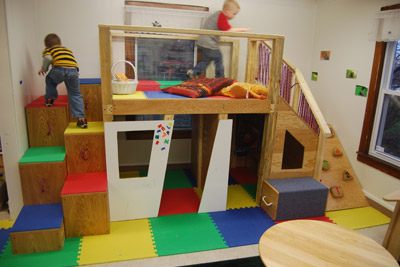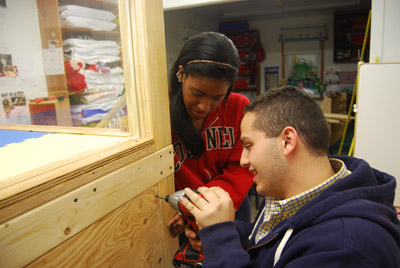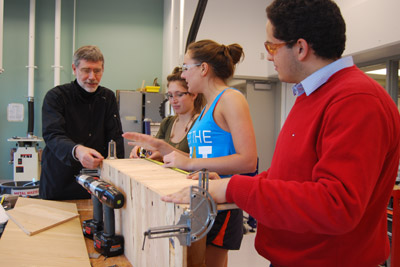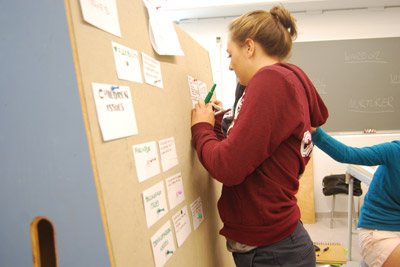Design students deliver new digs for local Head Start
By Ted Boscia




Cornell students take child's play seriously.
During the fall semester, 30 undergraduates blended design theory and behavioral science to remake classrooms at the Tompkins Cortland Community College (TC3) Head Start facility to better support the developmental needs of young children. Based on observations of children and interviews with teachers, the students custom-built colorful wooden furniture where the toddlers can eat, play, learn and socialize.
The project is part of a long-running partnership between two design and environmental analysis classes in the College of Human Ecology: Professor Gary Evans' The Environment and Social Behavior and a design studio taught by Professor Paul Eshelman. Since 1995, Eshelman and Evans have combined the courses, directing their students as they improved the design of local senior centers, Boys and Girls clubs, residence hall areas for students with physical disabilities and other facilities serving populations with unique needs.
"Interaction with real people draws the design experience out of the abstract," Eshelman said. "The students have been energized by interaction with representatives of the population for which they are designing."
In transforming the TC3 Head Start, overseen by Tompkins Community Action, the students formed teams focused on three distinct priorities: transition, the entryway where parents drop off children and store their belongings; nourishment, the central room where children eat and gather; and enrichment, multipurpose areas for play and group activities.
Evans' students researched the social, cognitive and developmental needs of the children, ages 3-5 from low-income families, and shared their findings with their design counterparts. In so-called "ideation" sessions, the designers devised how new furniture and changes to the facility layout could foster the children's intellectual, physical and emotional growth, and made initial sketches. Then, the teams fabricated full-scale furniture models in the new wood and metal shops and assembly room in the Human Ecology Building.
Their creations, Eshelman said, were "innovation solutions" that "break out of the box of conventional practice." The new transition area, for example, includes nook-like cubbies where children can stow their coats and backpacks, but also a space to sit and draw on a small easel.
"The design responds to the developmental need for personal retreat space," Eshelman said. Over time, however, he and students observed children leaning out of the nooks to talk to their peers, adding "an unanticipated social dimension."
Interior design student Arielle Levy '13 called the collaboration with her behavioral science peers "a wonderful change and addition to our usual design process." She valued their insights into toddlers' developmental needs and enjoyed the challenge of incorporating their evidence-based recommendations into the design teams' aesthetic vision.
"Their research gave our resulting concepts more meaning because of their social, cognitive and developmental relevance," she added.
Levy, part of the enrichment team, and her partners called on their own experiences as children in their concept. They wanted to replicate the idea of play forts -- sanctuaries where the children could retreat but also develop motor skills through climbing and mental and emotional skills through creative play.
"We wanted to create a structure that would allow the students to explore their own imaginations and have fun," she said.
Levy knew they had triumphed when she watched the youngsters clambering atop the structure and using hardhats and plastic saws to act out a show for their teachers.
"The children were ecstatic about the new furniture," she added. "It was rewarding to design and actually build something that brings joy to children daily."
Ted Boscia is assistant director of communications for the College of Human Ecology.
Media Contact
Get Cornell news delivered right to your inbox.
Subscribe